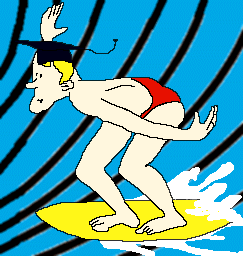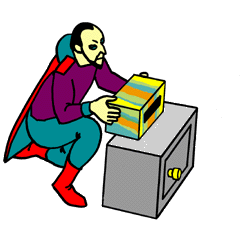CINE: Cartoon Images for the Network Education (CINE)
The CINE project, funded under the Electronic Libraries Training and Awareness programme, began in April 1996, and promised:
“The approach will consist of short (2-5 minutes) animated sequences, designed to answer very general “how does it work?” questions. These animations are intended to be entertaining, concise, and informative about fairly broad concepts. They would use both conventional cartoon character animation as well as more schematic displays showing data lookups, transformations, and the way processes are managed across networks.”
Although four months later than planned, three animations meeting that specification, on Z39.50, the World Wide Web, and Text Searching, have now been completed.
Seasoned animators, of both the computer and the pen-and-ink varieties, say “ANIMATION TAKES A LONG TIME.” I had heard this many times before embarking upon CINE. I nodded my head in acknowledgement, but carried on regardless. Not until one begins animation in earnest does the magnitude of the exercise, and the profound truth contained in the warning above, really hit home. At the most basic level, a 5-minute movie will require 4500 frames. Even allowing for pauses, and phases in which the animation runs slower, the amount of raw artwork required is still formidable.

But animation is not just artwork. The foundation of an animation is the storyboard. This is a skeletal version of the entire story, resembling a cartoon strip, with key pictures, dialogue, and approximate timings and scripting notes. Before the storyboard is constructed, the story itself must be generated. In order to do this, there must be a stock of ideas centred around the story topic.
So, long before pencil is first put to paper, a long period of thinking and discussion is required: about the subject, about the key elements of that subject, about ways in which those elements may be linked together, and about a setting which will provide a vehicle for those elements and make them into a story.
After that, a different kind of effort is required: producing the drawings which will expand the storyboard into an animation. At this stage it is essential to decide upon a set of standards for drawing size, colour depth, colour palette, and drawing resolution. Once the animation machine goes into production, these standards should be adhered to rigidly because variations are difficult or impossible to rectify. For example, resizing bitmapped drawings will almost invariably reduce the quality of the drawing. This is not a trivial exercise!

Having reached the stage where drawings have been accumulated and ordered, animation can begin. In CINE, drawings were imported into the Macromedia Director program. In addition to providing all the functionality necessary for producing movies, Director has additional utilities for compressing the movies for more economical network transmission, and a WWW browser plug-in (Shockwave) which displays Director movies within a WWW page.
By now, we had diverged from the original storyboards. Viewing them critically, while cooling off after the frantic heat of meeting the storyboard deadline, it was clear that there was much that could be improved. But - although some sequences were reworked, and we reduced the number of metaphors present, time’s wing’d chariot was heard again, all too soon…
So began the laborious task of importing pictures into Director, of sequencing and positioning, of timing, of checking colours, of adding interactive buttons, and of adding text.
The text element, replacing the planned audio narrative and dialogue, was an early admission of defeat. Without professional actors, and a professional recording studio, voiceovers would detract from, rather than add to, the final product. We did not have enough time or money to do that job properly: hence the inclusion of subtitles.

After initial compilation of the movies, it was necessary to run through them several times, editing for continuity, timing, alignment, and the general story sense. Without a deadline, the process of editing could have gone on indefinitely. Fortunately - fortune being relative - we had committed ourselves to a public presentation at the JANET User Support Workshop at King’s College London, in September 1997. So one day in late August the Director programme was closed down for the final time.
I still strongly support the initial reasons for the use of animation in training: movement to hold the attention of the viewer, movement to illustrate the flow of information, and graphical images to represent concepts by analogy. But it is hard to see how the procedures required could ever become viable for day-to-day production of materials. This is emphatically not intended to deter other would-be animators! A summary of what we did and how we did it will be available soon on the CINE WWW site.
So there you have it: the movies are currently undergoing evaluation, and will be made available to the academic community soon afterwards. Anyone who might be interested in taking part in the evaluation exercise, particularly those involved in training, should contact me at the email address below.
References
[1] CINE
http://www.kcl.ac.uk/projects/cine
Author Details
Frances BlomeleyKing’s College London
f.blomeley@kcl.ac.uk
